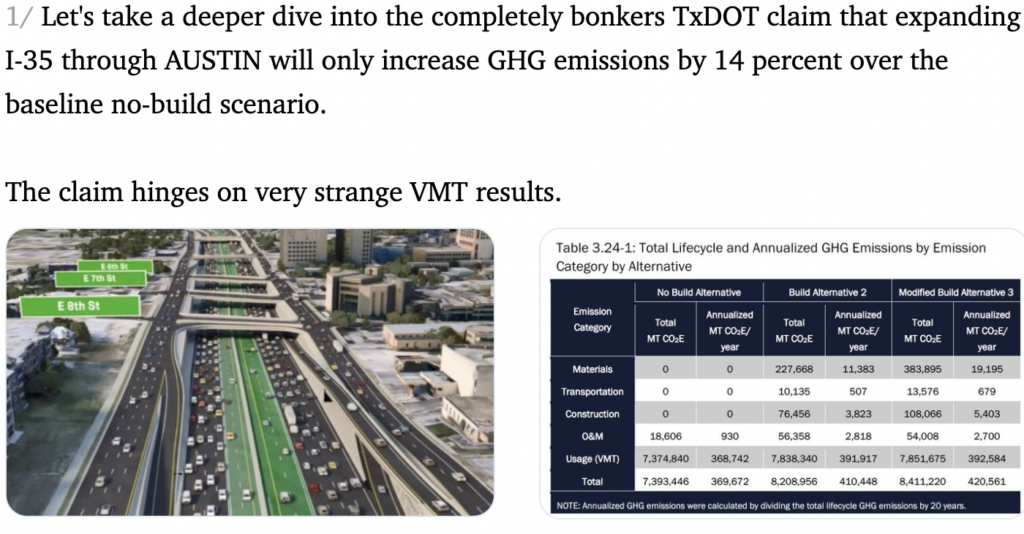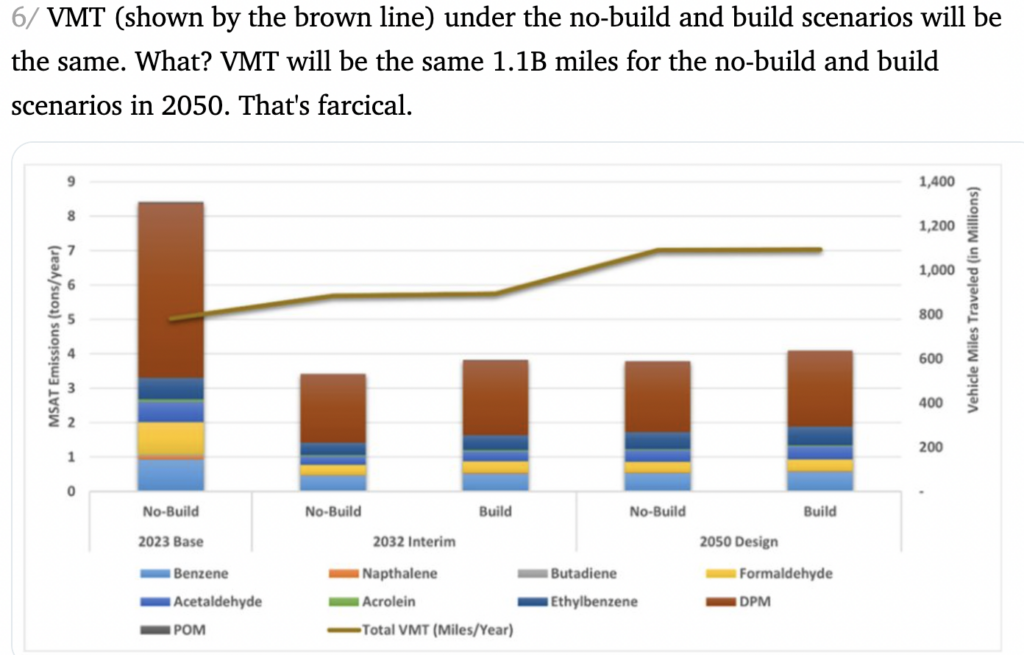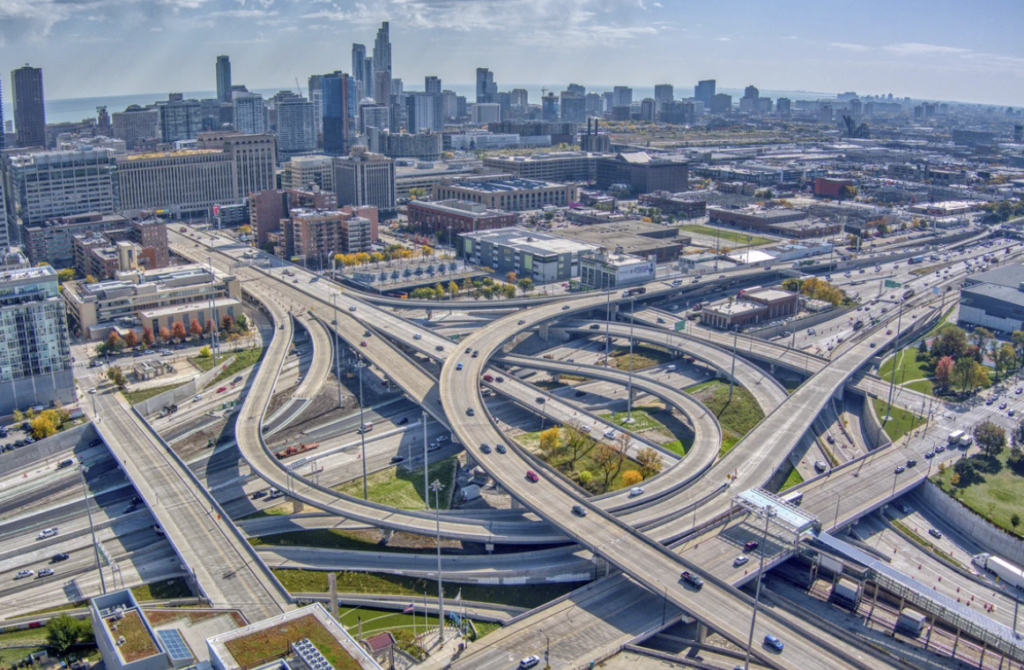What City Observatory did this week
Metro’s Climate-Denial Regional Transportation Plan. Portland’s regional governtment, Metro, has published a draft Regional Transportation Plan, outlining priorities for transportation investments for the next two decades, and ostensibly, aiming to deal with transportation greenhouse gas emissions, the largest source of climate pollution in the region. But unfortunately, the RTP, does nothing to prioritize projects and expenditures that reduce greenhouse gases, and instead creates a fictional case for more road widening.
Metro falsely asserts that because its overall plan will be on a path to reduce GHGs (it wont), it can simply ignore the greenhouse gas emissions of spending billions to widen freeways
The RTP’s climate policies don’t apply to individual project selection; projects are prioritized on whether they reduce vehicle delay—a failed metric it uses to rationalize capacity expansions that simply induce additional travel and pollution
The RTP environmental analysis falsely assume that ODOT will impose aggressive state charges on car travel, including carbon taxes, a mileage fee and congestion fees than have not been implemented—and may never be—to reduce vehicle miles traveled.
The RTP’s traffic modeling fails to incorporate the effect of expected pricing on the need for additional capacity. Modeling done by ODOT shows that pricing would eliminate the need for capacity expansion, saving billions, and reducing greenhouse gases.
Must Read
TXDOT marches ahead with I-35 Freeway widening. The Texas Department of Transportation has published its final environmental. report and record of decision for its multi-billion dollar I-35 widening project in Central Austin.
Kevin DeGood of the Center for American Progress has a devastating analysis of the project’s absurd environmental claims, which assert that adding multiple lanes the the roadway will have essentially a trivial impact on vehicle miles traveled and greenhouse gas emissions.
The TXDOT model essentially predicts that traffic on I-35 will increase by the same amount whether or not the roadway is widened—notwithstanding that the existing roadway is essentially at capacity much of the day. (We’ve unrolled DeGood’s social media thread for easy reading). The underlying reason for this is that TXDOT lives in a fictional world where traffic increases 1.5 percent per year, regardless of roadway capacity. TXDOT is simply in denial about the induced travel effects of building additional road capacity. The induced travel effect means that widening I-35 will increase driving and greenhouse gas emissions, and won’t solve congestion. It’s a great way to squander billions of dollars and further blight the middle of Austin.
Why speed enforcement cameras are equitable. Writing at CalMatters, Darnell Grigsby challenges the claim that automated traffic enforcement will unfairly affect low income households and persons of color.
As a Black man who has worked at the intersection of transportation and social justice for years, I know firsthand that calls for enforcement are complicated. High-profile police brutality cases stemming from traffic stops that spread on social media are not only a tragedy, but a reminder of the disparate impact and fear Black and brown drivers experience every day.
Grigbsby points out that unlike discretionary police enforcement, automated cameras are color-blind, and perhaps more importantly, low income and communities of color are much more affected by the traffic violence and quality of life impacts of speeding vehicles.
. . . communities of color bear the brunt of the pain from the increase in lawlessness on our roads. In fact, in California, Black pedestrians are 62% more likely to die than white Californians. Latinos are 31% more likely.
A transportation system designed by “a cabal of sentient cement-mixers.” Bella Chu (@bellachu10) is one of the most incisive and clear voices on transportation on social media. This week, the American Society of Civil Engineers dispensed its awards for highway construction and deemed the massive Jane Byrne freeway interchange in Chicago “an outstanding engineering achievement and improvement to the community!”
Bella’s take is spot-on:
OMG. It’s the @aashtospeaks “QoL & Community” awards all over again. If a cabal of sentient cement mixers whose only goal was to eliminate the human population via blunt force trauma, asthma and climate change had taken over the planet, they could not come up with a better plan.
New Knowledge
A profile of work from home. The Covid-19 pandemic greatly accelerated the adoption of work-at-home in the US economy, and though the pandemic has faded, work-from-home is far more common now that prior to the pandemic. A new paper from Barrero, Bloom and Davis describes the evolution of work from home.
While work from home is common for many professional service and information occupations, it’s still the case that 60 percent of US workers perform their jobs only at their workplace. About 11 percent of all workers work exclusively from home and the remaining 30 percent of workers are “hybrid”, splitting their working hours between workplaces and home.
Industry, occupation, and geography all influence whether and how much people work at home. Some industries (retailing, food services and manufacturing) require all or nearly all of their employees to be in the workplace; other industries (software, information) have much more remote work.
Remote work also varies by geography. Work from home is more common in denser locations than in more rural locations. In part, this reflects the mix of industries and occupations in different places. But it also reflects the advantages urban locations provide in terms of amenities near worker’s homes.
Jose Maria Barrero, Nicholas Bloom, and Steven J. Davis, “The Evolution of Working from Home,” https://wfhresearch.com, July 2023
In the news
The Portland Oregonian published Joe Cortright’s opinion piece on the Interstate Bridge: “Oregon’s funding plan for the Interstate Bridge is a generational crime.”
Thanks to Streetsblog California for pointing its reader’s to City Observatory’s analysis of climate fraud in the Portland Metro Regional Transportation Plan.






